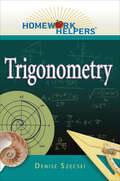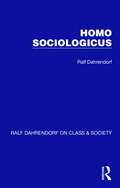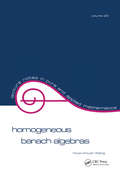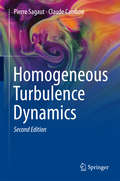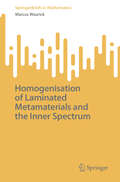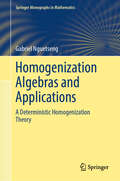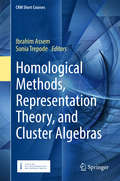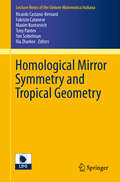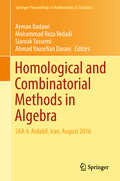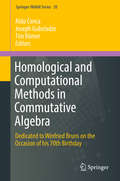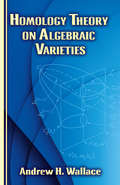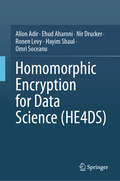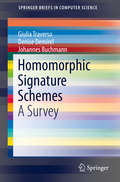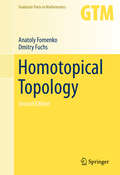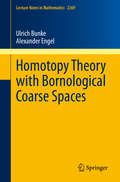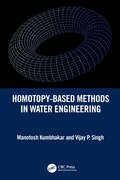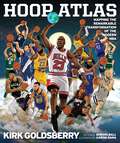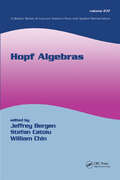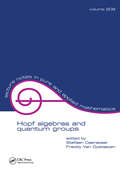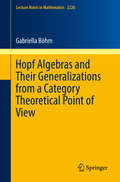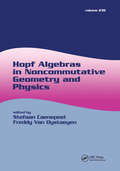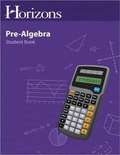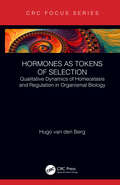- Table View
- List View
Homework Helpers: Trigonometry (Homework Helpers)
by Denise SzecseiThe essential help you need when your trigonometry textbook just isn’t making the grade!Trigonometry includes concepts that have both a geometric and an algebraic component. Homework Helpers: Trigonometry covers all of the topics in a typical trigonometry class, including:The unit circleTrigonometric functionsInverse trigonometric functionsIdentitiesGraphical analysisApplicationsThis book also contains a review of the algebraic and geometric ideas that are the foundation of trigonometry. Let a longtime teacher with a PhD in mathematics give you the boost you need to pass the class, prepare for an AP course, or just strengthen your skills.
Homo Sociologicus (Ralf Dahrendorf on Class & Society #3)
by Ralf DahrendorfFirst published in English as part of the Essays in the Theory of Society, this volume reissues the stand-alone Homo Sociologicus for which the author wrote a new introduction when it was originally published in 1973. The controversial book deals with the history, significance and limits of the category of social role and discusses the dilemma posed by homo sociologicus. The author shows that for society and sociology, socialization invariably means depersonalization, the yielding up of man’s absolute individuality and liberty to the constraint and generality of social roles. This volume includes the essay, Sociology and Human Nature, written as a postscript to Homo Sociologicus.
Homogeneous Banach Algebras
by Hwai-Chiuan WangThis book examines some aspects of homogeneous Banach algebras and related topics to illustrate various methods used in several classes of group algebras. It guides the reader toward some of the problems in harmonic analysis such as the problems of factorizations and closed subalgebras.
Homogeneous Turbulence Dynamics
by Pierre Sagaut Claude CambonThis book provides state-of-the-art results and theories in homogeneous turbulence, including anisotropy and compressibility effects with extension to quantum turbulence, magneto-hydodynamic turbulence and turbulence in non-newtonian fluids. Each chapter is devoted to a given type of interaction (strain, rotation, shear, etc.), and presents and compares experimental data, numerical results, analysis of the Reynolds stress budget equations and advanced multipoint spectral theories. The role of both linear and non-linear mechanisms is emphasized. The link between the statistical properties and the dynamics of coherent structures is also addressed. Despite its restriction to homogeneous turbulence, the book is of interest to all people working in turbulence, since the basic physical mechanisms which are present in all turbulent flows are explained. The reader will find a unified presentation of the results and a clear presentation of existing controversies. Special attention is given to bridge the results obtained in different research communities. Mathematical tools and advanced physical models are detailed in dedicated chapters.
Homogenisation of Laminated Metamaterials and the Inner Spectrum (SpringerBriefs in Mathematics)
by Marcus WaurickThis book investigates homogenisation problems for divergence form equations with rapidly sign-changing coefficients. Focusing on problems with piecewise constant, scalar coefficients in a (d-dimensional) crosswalk type shape, we will provide a limit procedure in order to understand potentially ill-posed and non-coercive settings. Depending on the integral mean of the coefficient and its inverse, the limits can either satisfy the usual homogenisation formula for stratified media, be entirely degenerate or be a non-local differential operator of 4th order. In order to mark the drastic change of nature, we introduce the &‘inner spectrum&’ for conductivities. We show that even though 0 is contained in the inner spectrum for all strictly positive periods, the limit inner spectrum can be empty. Furthermore, even though the spectrum was confined in a bounded set uniformly for all strictly positive periods and not containing 0, the limit inner spectrum might have 0 as an essential spectral point and accumulate at ∞ or even be the whole of C. This is in stark contrast to the classical situation, where it is possible to derive upper and lower bounds in terms of the values assumed by the coefficients in the pre-asymptotics. Along the way, we also develop a theory for Sturm–Liouville type operators with indefinite weights, reduce the question on solvability of the associated Sturm–Liouville operator to understanding zeros of a certain explicit polynomial and show that generic real perturbations of piecewise constant coefficients lead to continuously invertible Sturm–Liouville expressions.
Homogenization Algebras and Applications: A Deterministic Homogenization Theory (Springer Monographs in Mathematics)
by Gabriel NguetsengThe book presents a deterministic homogenization theory intended for the mathematical analysis of non-stochastic multiscale problems, both within and beyond the periodic setting. The main tools are the so-called homogenization algebras, the classical Gelfand representation theory, and a class of actions by the multiplicative group of positive real numbers on numerical spaces. The basic approach is the Sigma-convergence method, which generalizes the well-known two-scale convergence procedure. Numerous problems are worked out to illustrate the theory and highlight its broad applicability. The book is primarily intended for researchers (including PhD students) and lecturers interested in periodic as well as non-periodic homogenization theory.
Homological Methods, Representation Theory, and Cluster Algebras (Crm Short Courses Ser.)
by Ibrahim Assem Sonia TrepodeThis text presents six mini-courses, all devoted to interactions between representation theory of algebras, homological algebra, and the new ever-expanding theory of cluster algebras. The interplay between the topics discussed in this text will continue to grow and this collection of courses stands as a partial testimony to this new development. The courses are useful for any mathematician who would like to learn more about this rapidly developing field; the primary aim is to engage graduate students and young researchers. Prerequisites include knowledge of some noncommutative algebra or homological algebra. Homological algebra has always been considered as one of the main tools in the study of finite-dimensional algebras. The strong relationship with cluster algebras is more recent and has quickly established itself as one of the important highlights of today’s mathematical landscape. This connection has been fruitful to both areas—representation theory provides a categorification of cluster algebras, while the study of cluster algebras provides representation theory with new objects of study.The six mini-courses comprising this text were delivered March 7–18, 2016 at a CIMPA (Centre International de Mathématiques Pures et Appliquées) research school held at the Universidad Nacional de Mar del Plata, Argentina. This research school was dedicated to the founder of the Argentinian research group in representation theory, M.I. Platzeck.The courses held were:Advanced homological algebraIntroduction to the representation theory of algebrasAuslander-Reiten theory for algebras of infinite representation typeCluster algebras arising from surfacesCluster tilted algebrasCluster charactersIntroduction to K-theoryBrauer graph algebras and applications to cluster algebras
Homological Mirror Symmetry and Tropical Geometry
by Ricardo Castano-Bernard Fabrizio Catanese Maxim Kontsevich Tony Pantev Yan Soibelman Ilia ZharkovThe relationship between Tropical Geometry and Mirror Symmetry goes back to the work of Kontsevich and Y. Soibelman (2000), who applied methods of non-archimedean geometry (in particular, tropical curves) to Homological Mirror Symmetry. In combination with the subsequent work of Mikhalkin on the "tropical" approach to Gromov-Witten theory and the work of Gross and Siebert, Tropical Geometry has now become a powerful tool. Homological Mirror Symmetry is the area of mathematics concentrated around several categorical equivalences connecting symplectic and holomorphic (or algebraic) geometry. The central ideas first appeared in the work of Maxim Kontsevich (1993). Roughly speaking, the subject can be approached in two ways: either one uses Lagrangian torus fibrations of Calabi-Yau manifolds (the so-called Strominger-Yau-Zaslow picture, further developed by Kontsevich and Soibelman) or one uses Lefschetz fibrations of symplectic manifolds (suggested by Kontsevich and further developed by Seidel). Tropical Geometry studies piecewise-linear objects which appear as "degenerations" of the corresponding algebro-geometric objects.
Homological and Combinatorial Methods in Algebra: Saa 4, Ardabil, Iran, August 2016 (Springer Proceedings In Mathematics And Statistics Series #228)
by Ayman Badawi Mohammad Reza Vedadi Siamak Yassemi Ahmad Yousefian DaraniBased on the 4th Seminar on Algebra and its Applications organized by the University of Mohaghegh Ardabili, this volume highlights recent developments and trends in algebra and its applications. Selected and peer reviewed, the contributions in this volume cover areas that have flourished in the last few decades, including homological algebra, combinatorial algebra, module theory and linear algebra over rings, multiplicative ideal theory, and integer-valued polynomials. Held biennially since 2010, SAA introduces Iranian faculty and graduate students to important ideas in the mainstream of algebra and opens channels of communication between Iranian mathematicians and algebraists from around the globe to facilitate collaborative research. Ideal for graduate students and researchers in the field, these proceedings present the best of the seminar’s research achievements and new contributions to the field.
Homological and Computational Methods in Commutative Algebra
by Aldo Conca Joseph Gubeladze Tim RömerThis volume collects contributions by leading experts in the area of commutative algebra related to the INdAM meeting "Homological and Computational Methods in Commutative Algebra" held in Cortona (Italy) from May 30 to June 3, 2016 . The conference and this volume are dedicated to Winfried Bruns on the occasion of his 70th birthday. In particular, the topics of this book strongly reflect the variety of Winfried Bruns' research interests and his great impact on commutative algebra as well as its applications to related fields. The authors discuss recent and relevant developments in algebraic geometry, commutative algebra, computational algebra, discrete geometry and homological algebra. The book offers a unique resource, both for young and more experienced researchers seeking comprehensive overviews and extensive bibliographic references.
Homology Theory on Algebraic Varieties: Homology Theory On Algebraic Varieties (Dover Books on Mathematics #Volume 6)
by Andrew H. WallaceConcise and authoritative, this monograph is geared toward advanced undergraduate and graduate students. The main theorems whose proofs are given here were first formulated by Lefschetz and have since turned out to be of fundamental importance in the topological aspects of algebraic geometry. The proofs are fairly elaborate and involve a considerable amount of detail; therefore, some appear in separate chapters that include geometrical descriptions and diagrams.The treatment begins with a brief introduction and considerations of linear sections of an algebraic variety as well as singular and hyperplane sections. Subsequent chapters explore Lefschetz's first and second theorems with proof of the second theorem, the Poincaré formula and details of its proof, and invariant and relative cycles.
Homomorphic Encryption for Data Science (HE4DS)
by Allon Adir Ehud Aharoni Nir Drucker Ronen Levy Hayim Shaul Omri SoceanuThis book provides basic knowledge required by an application developer to understand and use the Fully Homomorphic Encryption (FHE) technology for privacy preserving Data-Science applications. The authors present various techniques to leverage the unique features of FHE and to overcome its characteristic limitations. Specifically, this book summarizes polynomial approximation techniques used by FHE applications and various data packing schemes based on a data structure called tile tensors, and demonstrates how to use the studied techniques in several specific privacy preserving applications. Examples and exercises are also included throughout this book. The proliferation of practical FHE technology has triggered a wide interest in the field and a common wish to experience and understand it. This book aims to simplify the FHE world for those who are interested in privacy preserving data science tasks, and for an audience that does not necessarily have a deep cryptographic background, including undergraduate and graduate-level students in computer science, and data scientists who plan to work on private data and models.
Homomorphic Signature Schemes
by Giulia Traverso Denise Demirel Johannes BuchmannHomomorphic signature schemes are an important primitive for many applications and since their introduction numerous solutions have been presented. Thus, in this work we provide the first exhaustive, complete, and up-to-date survey about the state of the art of homomorphic signature schemes. First, the general framework where homomorphic signatures are defined is described and it is shown how the currently available types of homomorphic signatures can then be derived from such a framework. In addition, this work also presents a description of each of the schemes presented so far together with the properties it provides. Furthermore, three use cases, electronic voting, smart grids, and electronic health records, where homomorphic signature schemes can be employed are described. For each of these applications the requirements that a homomorphic signature scheme should fulfill are defined and the suitable schemes already available are listed. This also highlights the shortcomings of current solutions. Thus, this work concludes with several ideas for future research in the direction of homomorphic signature schemes.
Homotopical Topology
by Anatoly Fomenko Dmitry FuchsThis textbook on algebraic topology updates a popular textbook from the golden era of the Moscow school of I. M. Gelfand. The first English translation, done many decades ago, remains very much in demand, although it has been long out-of-print and is difficult to obtain. Therefore, this updated English edition will be much welcomed by the mathematical community. Distinctive features of this book include: a concise but fully rigorous presentation, supplemented by a plethora of illustrations of a high technical and artistic caliber; a huge number of nontrivial examples and computations done in detail; a deeper and broader treatment of topics in comparison to most beginning books on algebraic topology; an extensive, and very concrete, treatment of the machinery of spectral sequences. The second edition contains an entirely new chapter on K-theory and the Riemann-Roch theorem (after Hirzebruch and Grothendieck).
Homotopy Theory with Bornological Coarse Spaces (Lecture Notes in Mathematics #2269)
by Ulrich Bunke Alexander EngelProviding a new approach to assembly maps, this book develops the foundations of coarse homotopy using the language of infinity categories. It introduces the category of bornological coarse spaces and the notion of a coarse homology theory, and further constructs the universal coarse homology theory. Hybrid structures are introduced as a tool to connect large-scale with small-scale geometry, and are then employed to describe the coarse motives of bornological coarse spaces of finite asymptotic dimension. The remainder of the book is devoted to the construction of examples of coarse homology theories, including an account of the coarsification of locally finite homology theories and of coarse K-theory. Thereby it develops background material about locally finite homology theories and C*-categories. The book is intended for advanced graduate students and researchers who want to learn about the homotopy-theoretical aspects of large scale geometry via the theory of infinity categories.
Homotopy-Based Methods in Water Engineering
by Vijay P. Singh Manotosh KumbhakarMost complex physical phenomena can be described by nonlinear equations, specifically, differential equations. In water engineering, nonlinear differential equations play a vital role in modeling physical processes. Analytical solutions to strong nonlinear problems are not easily tractable, and existing techniques are problem-specific and applicable for specific types of equations. Exploring the concept of homotopy from topology, different kinds of homotopy-based methods have been proposed for analytically solving nonlinear differential equations, given by approximate series solutions. Homotopy-Based Methods in Water Engineering attempts to present the wide applicability of these methods to water engineering problems. It solves all kinds of nonlinear equations, namely algebraic/transcendental equations, ordinary differential equations (ODEs), systems of ODEs, partial differential equations (PDEs), systems of PDEs, and integro-differential equations using the homotopy-based methods. The content of the book deals with some selected problems of hydraulics of open-channel flow (with or without sediment transport), groundwater hydrology, surface-water hydrology, general Burger’s equation, and water quality. Features: Provides analytical treatments to some key problems in water engineering Describes the applicability of homotopy-based methods for solving nonlinear equations, particularly differential equations Compares different approaches in dealing with issues of nonlinearity
Hoop Atlas: Mapping the Remarkable Transformation of the Modern NBA
by Kirk Goldsberry"When discussing greatness, we have too often distilled it down to how many rings someone has won, neglecting to celebrate the incredible influence that players have had on the evolution of basketball. Kirk's book beautifully explains this other side of greatness—how one player's skill and style of play can change the game forever."—JJ RedickThe bestselling author of Sprawlball, Kirk Goldsberry returns with a visual feast of a book—equal parts Book of Basketball and Shea Serrano—that uses sharp writing, his signature graphics, and cutting-edge statistical analyses to unpack how a handful of NBA superstars —MJ to Lebron to Jokic—have reshaped pro basketball and charted the course to the future of the NBA.Every few years a talent comes along that disrupts everything we think we know about how the NBA should work. Whether it’s scoring, playmaking, or shooting, these are players and tactics that fundamentally challenge how the game is played and what greatness looks like on a basketball court. For a period of time, these players each become an “Atlas” for the league, carrying the weight of the NBA on their shoulders, but also providing the roadmap that points the way to the future of the sport. In tandem, they map out the modern NBA’s creation.Goldsberry returns with a highly visual, electrifying tour through the last three decades of NBA history, showing the “Atlas” players that have led us out of the brutishness of 90s hoops and into the wide open spaces of the most skilled era in NBA history. Charting the course from Jordan to Jokic—with plenty of stops along the way for Iverson, Kobe, Curry, and of course Lebron—Goldsberry, who was instrumental in helping spur the NBA’s statistical revolution, has designed a vibrant new way to compare and debate the contributions of the best NBA players of all-time. Masterfully connecting NBA past and present through incisive writing and stunning visual statistical analyses, he shows how we’ve come to this unprecedented moment, a time when offensive efficiency and shooting percentages are higher than ever.Using beautifully designed, four-color shot maps and illustrations, Goldsberry offers a graphic journey through the last thirty years of the NBA that covers up to the 2023 season and is as much fun to look at as it is to read. The end result offers stories and analyses of a select group of NBA superstars that open up lively debates, reveal just how singular their talents truly are, and characterize the dramatic 21st-century metamorphosis of the best basketball league in the world.
Hopf Algebras
by Jeffrey Bergen Stefan Catoiu William ChinThis volume publishes key proceedings from the recent International Conference on Hopf Algebras held at DePaul University, Chicago, Illinois. With contributions from leading researchers in the field, this collection deals with current topics ranging from categories of infinitesimal Hopf modules and bimodules to the construction of a Hopf algebraic
Hopf Algebras and Quantum Groups (Lecture Notes in Pure and Applied Mathematics #Vol. 209)
by Freddy Van Oystaeyen Stefaan CaenepeelThis volume is based on the proceedings of the Hopf-Algebras and Quantum Groups conference at the Free University of Brussels, Belgium. It presents state-of-the-art papers - selected from over 65 participants representing nearly 20 countries and more than 45 lectures - on the theory of Hopf algebras, including multiplier Hopf algebras and quantum g
Hopf Algebras and Their Generalizations from a Category Theoretical Point of View (Lecture Notes in Mathematics #2226)
by Gabriella BöhmThese lecture notes provide a self-contained introduction to a wide range of generalizations of Hopf algebras. Multiplication of their modules is described by replacing the category of vector spaces with more general monoidal categories, thereby extending the range of applications. Since Sweedler's work in the 1960s, Hopf algebras have earned a noble place in the garden of mathematical structures. Their use is well accepted in fundamental areas such as algebraic geometry, representation theory, algebraic topology, and combinatorics. Now, similar to having moved from groups to groupoids, it is becoming clear that generalizations of Hopf algebras must also be considered. This book offers a unified description of Hopf algebras and their generalizations from a category theoretical point of view. The author applies the theory of liftings to Eilenberg–Moore categories to translate the axioms of each considered variant of a bialgebra (or Hopf algebra) to a bimonad (or Hopf monad) structure on a suitable functor. Covered structures include bialgebroids over arbitrary algebras, in particular weak bialgebras, and bimonoids in duoidal categories, such as bialgebras over commutative rings, semi-Hopf group algebras, small categories, and categories enriched in coalgebras. Graduate students and researchers in algebra and category theory will find this book particularly useful. Including a wide range of illustrative examples, numerous exercises, and completely worked solutions, it is suitable for self-study.
Hopf Algebras in Noncommutative Geometry and Physics (Lecture Notes in Pure and Applied Mathematics #Vol. 239)
by Freddy Van Oystaeyen Stefaan CaenepeelThis comprehensive reference summarizes the proceedings and keynote presentations from a recent conference held in Brussels, Belgium. Offering 1155 display equations, this volume contains original research and survey papers as well as contributions from world-renowned algebraists. It focuses on new results in classical Hopf algebras as well as the
Horizons Pre-Algebra
by M. S. Shelly ChittamIntroduce your junior high student to the world of advanced math with the Horizons Pre-Algebra Student Book from Alpha Omega Publications! Containing 160 colorful lessons with perforated pages for easy removal, this Horizons math workbook teaches your child volume and surface area of solids, four operations with monomials and polynomials, representations of data, trigonometric ratios, and more. A tests and resources book is sold separately.
Hormones as Tokens of Selection: Qualitative Dynamics of Homeostasis and Regulation in Organismal Biology
by Hugo van den BergHormones as Tokens of Selection addresses deep questions in biology: How are biological systems controlled? How can one formulate general theories of homeostasis and control and instantiate such theories in mathematical models? How can one use evolutionary arguments to guide our answers to these questions, recognising that the control mechanisms themselves are a product of evolution? Biological systems are exceptionally varied and extremely difficult to understand, because they are complex and experimentation remains limited relative to the challenges at hand. Moreover, biological phenomena occur at a wide range of temporal and spatial scales. Such a deeply convoluted subject calls for a unifying and coherent theoretical foundation — one which recognises and departs from the primary importance of mathematical modelling and key physicochemical principles to theory formation in the life sciences. This Focus monograph proposes and outlines such a foundation, departing from the deceptively simple proposition that hormones are tokens of evolutionary pressures. Features Provides a coherent and unified approach to a multifaceted problem Pays close attention to both the biological and mathematical modelling aspects of the subject matter, exploring the philosophical background where appropriate Written in a concise and innovative style
Hot X: Algebra Exposed
by Danica Mckellar"New York Times" bestselling author McKellar tackles the toughest math class yet: algebra. She shows teenage girls--and anyone taking algebra--how to feel confident, get in the driver's seat, and master topics like square roots, polynomials, quadratic equations, word problems, and more.
Houghton Mifflin Harcourt Algebra 1
by Timothy D. Kanold Edward B. Burger Juli K. Dixon Steven J. Leinwand Matthew R. LarsonHMH Algebra 1 is built on the 5E instructional model-Engage, Explore, Explain, Elaborate, Evaluate-to develop strong conceptual understanding and mastery of key mathematics standards.
